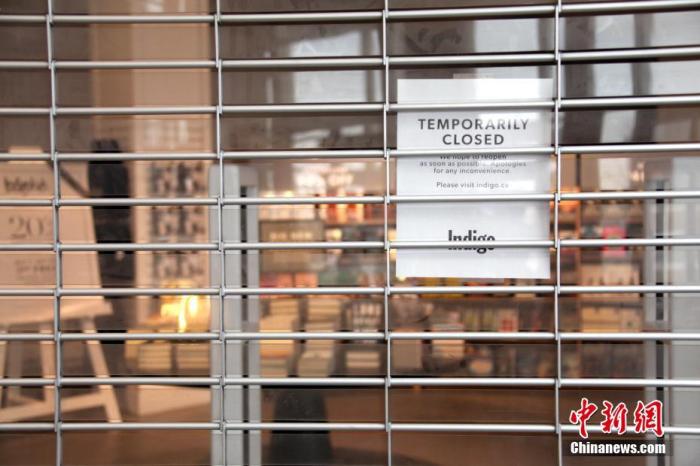China News Agency Toronto, April 4th, Question: Canadians' "mask view" quietly shakes
China News Service reporter Yu Ruidong
Faced with the escalating pressure of the new coronary pneumonia epidemic, Canadians ’inherent beliefs about wearing masks are shaking.
Like most Western countries, the general perception of Canadians about masks is that patients only need to wear masks, and healthy people do not.
After the new crown epidemic occurred, the Public Health Agency of Canada also reminded that effective anti-epidemic measures are washing hands, coughing or sneezing with arms bent to cover, maintaining social distance, etc., does not include wearing masks.
On March 18, local time, a bookstore in Yorkdale shopping mall in Toronto, Canada, closed its doors to thank guests. China News Service reporter Yu Ruidong
Wearing a mask in public may even cause disgust. In mid-March, three Asians were expelled from the staff by wearing masks in a supermarket in Toronto.
Tan Yongshi, Canada ’s chief public health officer, who has played an important role in the decision-making of public health in Canada, has said many times earlier that wearing a mask is not an effective method of epidemic prevention, and it is easy to cause more risks due to the hand touching the outside of the mask.
However, the epidemic situation is becoming more and more serious, and community transmission has become the main cause of the spread. Over the past few days, many mainstream TV stations and newspapers in Canada have begun to discuss whether all people should wear masks. Although many medical experts participating in the discussion support the opinions of the current public health department, some experts believe that even homemade masks can provide a certain degree of protection. Some medical experts have noticed the existence of asymptomatic infections. This is one of the rationalities for the public to wear masks.
Gao Fu, director of the Chinese Center for Disease Control and Prevention, told the media a few days ago that a major mistake in the prevention and control of European and American countries is not wearing a mask. His views were also quoted by some Canadian media.
Public health officials in Canada have recently begun to relax. When responding to the mask problem on social networks on April 1, Tan Yongshi insisted that medical masks can only be reserved for medical staff, but also emphasized the safe use of different types of masks on different occasions. On April 3, when she talked about the problem of asymptomatic patients, she said that the authorities are collecting relevant information, and subsequent findings may change existing public health recommendations. The Chief Health Officer of British Columbia (also translated into British Columbia) said on April 1 that "no objection" people widely use non-medical masks.
The Canadian Public Health Agency's tips to the public have also been slightly adjusted. The current expression is: wearing a non-medical mask is another measure that can protect people around. It is also good to wear a non-medical mask that will make you feel safer and prevent you from touching your mouth and nose, but do not touch your eyes. It is important to understand that non-medical masks have limitations and need to be used safely.
The BC Centers for Disease Control reminded that some people would choose to wear masks because of their culture and family background, which should be respected. "This is very important."
Canadian Television (CTV) launched an investigation on its website on April 3, "Whether everyone should wear a mask to stop the spread of the virus." As of the evening of the 4th, 80% of the approximately 19,000 survey participants chose “Yes”. In an earlier survey by the media on whether you wore a mask when you were out, 87% of the nearly 6,300 participants answered “no”.
However, the exhaustion of medical supplies such as masks is a major challenge for Canada in the fight against epidemics. At present, masks and alcohol disinfectants are still out of stock or in serious shortage in the consumer markets across Canada.
The Canadian Medical Association said on April 2 that more than one-third of community care facility doctors said that their N95 masks, face masks, etc. were only enough for 2 days or less. The association has sent a face-to-face report to the Canadian health minister and urged the government to resolve the material crisis.
Tan Yongshi also confessed at the end of March that the authorities did not plan to change the recommendations regarding masks. One was because medical staff lacked masks. The other was not sure whether masks really helped prevent infection.
However, on April 4, Tan Yongshi told the media for the first time that it is "a good idea" to use a non-medical mask as an additional covering to cover a cough, such as when it is impossible to maintain a distance of more than 2 meters from others.
Wang Peizhong, a tenured professor and epidemiology expert at the Newfoundland Memorial University School of Medicine in Canada, believes that the effectiveness of masks and the insufficient supply of masks are different from the correct use of masks. You can think of ways to solve the problem of masks, but you can learn how to use masks if you cannot use them correctly. Most of the literature available shows that the use of surgical masks can effectively reduce respiratory virus transmission.
Canadian Prime Minister Trudeau told the media on the 4th that millions of medical masks will be transported from China to Canada via charter flights within two days; the Canadian government has also leased warehouses in China in order to speed up the transfer of related materials. As of that night, the cumulative number of confirmed and suspected cases in Canada was 14,018, an increase of 1,363 from the previous day; and 233 related deaths. (Finish)

